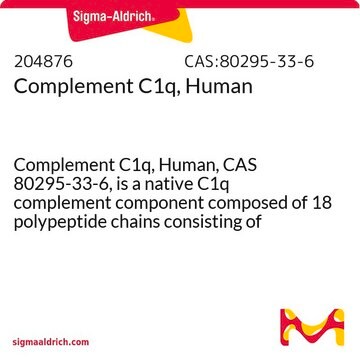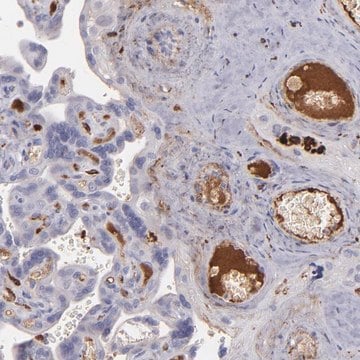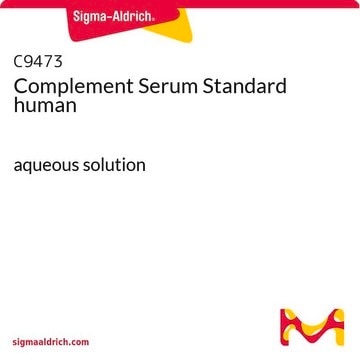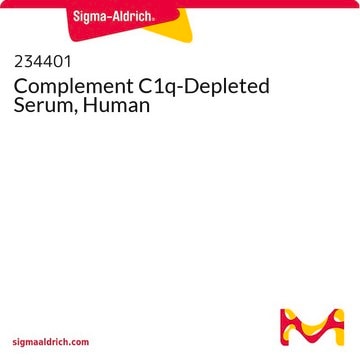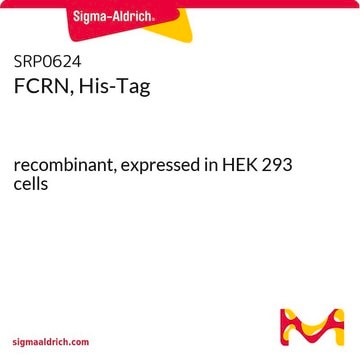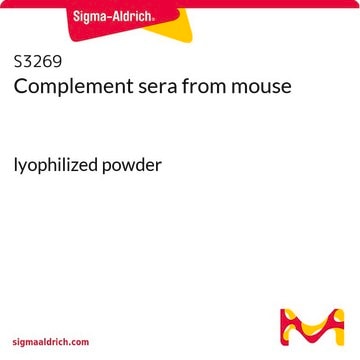This product corresponds to purified 'native' human C1q. Its sequence is not determined in-house. Please refer to published sequences, e.g. in GenBank for UniProt accession nos. P02745, P02746, & P02747.
C1740
Complement component C1q from human serum
≥95% (SDS-PAGE)
Sinônimo(s):
C1q from human serum
About This Item
Produtos recomendados
fonte biológica
human
Nível de qualidade
Ensaio
≥95% (SDS-PAGE)
Formulário
liquid
técnica(s)
activity assay: suitable
Condições de expedição
dry ice
temperatura de armazenamento
−70°C
Procurando produtos similares? Visita Guia de comparação de produtos
Descrição geral
Aplicação
Ações bioquímicas/fisiológicas
forma física
Código de classe de armazenamento
10 - Combustible liquids
Classe de risco de água (WGK)
WGK 3
Ponto de fulgor (°F)
Not applicable
Ponto de fulgor (°C)
Not applicable
Escolha uma das versões mais recentes:
Certificados de análise (COA)
Não está vendo a versão correta?
Se precisar de uma versão específica, você pode procurar um certificado específico pelo número do lote ou da remessa.
Já possui este produto?
Encontre a documentação dos produtos que você adquiriu recentemente na biblioteca de documentos.
Os clientes também visualizaram
-
I ordered the C1740-1MG with lot#0000356664. I would like to know the protein sequences and the extinction coefficient about this protein?
1 answer-
Helpful?
-
-
what is the size of the protein in WB ? when I test it's size it was approximately 24 KD ( the same size as c1q-c )
1 answer-
C1q is composed of 18 polypeptide chains (six A, six B, six C). When prepared in denaturing sample buffer, and run on SDS PAGE, the chains will likely dissociate and run at their individual molecular weights. The Uniprot entries for C1qA, C1qB, and C1qC list masses of 26,017, 26,722, and 25,774, respectively.
Helpful?
-
-
Is this product suitable for use in cell cultures?
1 answer-
This product has not been tested for suitability in cell culture. The end user will need to determine suitability. However, there are multiple publications citing the use of this product in cell culture applications. Please see the link below to review an example:
https://www.ncbi.nlm.nih.gov/pmc/articles/PMC4377823/Helpful?
-
-
Hola, me gustaría saber como se reconstituye el producto para su uso en ensayos. Gracias.
1 answer-
This product is not suitable for use in clinical trials. Unless otherwise stated, this product is intended for research use only. It is not suitable for any other purpose, which includes, but is not limited to, unauthorized commercial use, in vitro diagnostic use, or therapeutic use in humans or animals.
Helpful?
-
-
What is the concentration of C1740?
1 answer-
The product is supplied at a concentration of approximately 1 mg/ml. The exact concentration is lot specific and reported on the Certificate of Analysis.
Helpful?
-
Active Filters
Nossa equipe de cientistas tem experiência em todas as áreas de pesquisa, incluindo Life Sciences, ciência de materiais, síntese química, cromatografia, química analítica e muitas outras.
Entre em contato com a assistência técnica